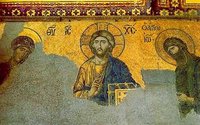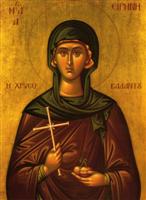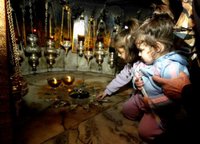 In one of my favorite icons Christ, the King of All, sits upon His eternal throne, holding in His left hand the Gospels that reveal Him to the world, and offering with His right hand the sign of blessing. His mother, the Virgin Mary, stands at His right hand while John the Baptist, His cousin and prophet, stands to His left. Both Mary and John are facing Him, lifting up their hands toward Him in prayer and supplication. They are standing before Christ, praying for us. Mary and John the Baptist are honored as first among all the Saints in heaven. These two, who have dedicated their whole lives to Christ, lead all the Saints in heaven in prayer for us, the Church on earth.
In one of my favorite icons Christ, the King of All, sits upon His eternal throne, holding in His left hand the Gospels that reveal Him to the world, and offering with His right hand the sign of blessing. His mother, the Virgin Mary, stands at His right hand while John the Baptist, His cousin and prophet, stands to His left. Both Mary and John are facing Him, lifting up their hands toward Him in prayer and supplication. They are standing before Christ, praying for us. Mary and John the Baptist are honored as first among all the Saints in heaven. These two, who have dedicated their whole lives to Christ, lead all the Saints in heaven in prayer for us, the Church on earth.The Archangel Gabriel appeared to Mary and announced to the young, innocent, virgin girl that she would miraculously give birth to a son, the very Son of God, who would be conceived in her by the Holy Spirit. She responded to Gabriel in perfect childlike faith, saying, “Behold the servant of the Lord! Let the things you have said happen according to your word.” Her response teaches us how we should respond to God in our own lives. Whatever God calls us to do, we should completely submit ourselves to His divine will so that we may fulfill His purpose and destiny for our lives. Mary is our model of faith, obedience, and selflessness. She was not only Jesus’ mother, but also one of His most loyal disciples. Christ was her Savior, her Lord, and her God. Her path of discipleship was not an easy one because she experienced Christ’s humiliation, rejection, suffering, and death, not only as His disciple, but also as His own mother, the one who carried Him in her womb, gave birth to Him in a cave, escaped with him to a foreign country to protect him, observed His miraculous ministry, beheld his rejection, witnessed his pain, and stood in the shadow of His cross. When Jesus was an infant, a holy man in the Temple named Simeon took him into His arms. After prophesying to Mary about what her son would face in life, he said to her, “A sword shall pierce your own soul too” (Luke 2.34). Indeed, she felt the pain of a sword as she watched her Son die, His broken body hanging by the nails of an executioner’s cross.
As Mary suffered with Christ, she was also filled with the joy of His resurrection. Her Son, whom she had seen crucified, was raised to immortal life, never to die again. He ascended into heaven, taking His rightful place as ruler over all creation. Many centuries after her own falling asleep, she now stands in the eternal presence of her Son, ceaselessly praying for us.
Before the Virgin May became pregnant with her divine child, Mary’s cousin Elizabeth conceived. The Archangel Gabriel told Elizabeth’s husband that their son, who would be named John, would prepare people’s hearts to receive the Lord when he came among them. Even before his birth, John recognized Jesus. When Mary visited John’s mother during their pregnancies, John leaped within Elizabeth’s womb in the presence of Mary and the unborn Jesus. During his life, John lived in the wilderness, preaching and baptizing in the Jordan River. He didn’t wear soft, fine robes, but rustic camel skins. As a prophet he tirelessly proclaimed to everyone about the One far greater than himself who would come after him whose sandals he was not worthy to untie. Jesus taught that John was the prophet revealed in the Holy Scripture when it said, “Behold, I send my messenger before thy face, who shall prepare thy way before thee” (Matt. 10.10, RSV). Because of his bold proclamation of the truth, John was imprisoned and beheaded by order of King Herod. John remained a loyal disciple of Jesus Christ throughout his life on earth. Today, he stands by the throne of Christ, with Mary and all the Saints of heaven, offering prayers for us.
May we always honor and bless the mother of our Lord and Savior, Jesus Christ, and his Forerunner and Prophet, the Baptist John. Let us remember their lives, follow their examples, and ask for their prayers that we too may live lives of purity, selflessness, love, humility, and perfect faith as dedicated disciples of Christ, our God.
Copyright © 2005 by Dana S. Kees. Adapted from “Our Life in the Saints,” The Mystery of You: A Collection of Writings, Vol. 1, Copyright © 2004 by Dana S. Kees. (The icon, called “Deisis,” is from the Church of Holy Wisdom (St. Sophia) in Constantinople. The image is in the public domain.)





